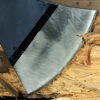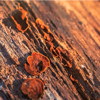Dry rot is the most dangerous and difficult fungus to combat in buildings. It can attack wood with a wood moisture content in the fibre saturation range, and can introduce moisture into dry wood, allowing the infestation to spread further. It grows through masonry and other inorganic materials and infests neighbouring wooden components.

Types of harmful organisms and influencing
factors for the damage of wooden structures
Wood structures can be damaged by wood-destroying fungi, usually as a result of sustained excess moisture levels or wood-destroying insects. Here, too, high wood moisture amplifies this effect, in addition to other influencing factors.
Whether due to errors in the design of timber constructions or their use: damage caused by fungal or insect infestation often very quickly reduces the structural integrity of load-bearing components. Remmers wood preservatives have been providing a safe remedy for this for decades – only in the hands of expert wood specialists, of course.
Damage caused by wood-destroying insects
House borer, powder post and death watch beetle
Determining the extent of the infestation
If a live infestation of dry-wood insects such as the house borer (Hylotrupes bajulus), death watch beetle (Anobiidae) or powder post beetle (Lyctidae) is detected, the extent of the infestation must first be determined. For this purpose, all structural timber must be checked for the intensity and extent of infestation at the accessible edges in the sapwood area by scribing, cutting open or drilling at an appropriate number of points. Wood-based materials should only be inspected for the presence of insect exit holes. Panelling or floorboards may need to be taken up. In areas that are difficult to access, e.g. in converted attics, the roof may need to be opened. In the case of historically valuable structural parts, it is best to avoid cutting open in order to preserve the visual appearance of the structure.
Insect species
-
House borer
-
Brown powder post beetle
-
Common furniture beetle
-
Death watch beetle
Stripping down to the intact areas and checking the structure

Selecting and applying a wood preservative
The wood surfaces exposed in this way can now be treated by brushing or spraying. The solvent-based Anti-Insect* must be applied in at least two coats and the salt-based product Adolit Wood Worm Free* in three coats. The required application quantity for control agents is 300 - 350 ml/m2. The effectiveness of wood preservatives for infestation control is determined by the active ingredients used. Fast or slow-acting agents are used. In the case of slow-acting products, it is possible for a living residual infestation (especially in the case of woodworm infestation) to still be present after up to 5 years. On historically valuable structural parts and in areas that are difficult to access, where it is not possible to remove the damaged parts or treat all sides with the protective agent, a borehole impregnation or borehole pressure impregnation must also be carried out. The latter is particularly advantageous when working overhead. Details on this special procedure can be found in the technical data sheets of the respective products.
* Use biocides safely. Always read the label and product information before use.
Damage caused by fungi
Different types of fungi
-
Brown cellar rot
-
Bracket fungi
-
Donkioporia expansa
-
Soft rot
Dry rot
Dry rot is the most dangerous and difficult fungus to combat in buildings. It can attack wood with a wood moisture content in the fibre saturation range, and can introduce moisture into dry wood, allowing the infestation to spread further. It grows through masonry and other inorganic materials and infests neighbouring wooden components.
Combating dry rot
-
Elimination of the cause
-
Treatment of the wood
-
Infestation on masonry
-
Surface treatment
-
Application of the mould barrier agent
-
Borehole treatment
-
Borehole impregnation under pressure
-
Follow-up work
General application instructions:
Control of other fungi
Determining the extent of the damage
A qualified expert must investigate the type and extent of damage and the resulting need for treatment.
Removing fungi and damaged areas
Remove mycelium, fruiting bodies and severely damaged wood, observing the safety distance specified in the standard; the wood must then be removed at least 30 cm beyond the visible infestation. In the case of slightly damaged wood whose load-bearing capacity has not been unduly impaired, it is sufficient to remove only the damaged areas down to the healthy wood.
Removing fungi and damaged areas
Remove mycelium, fruiting bodies and severely damaged wood, observing the safety distance specified in the standard; the wood must then be removed at least 30 cm beyond the visible infestation. In the case of slightly damaged wood whose load-bearing capacity has not been unduly impaired, it is sufficient to remove only the damaged areas down to the healthy wood.
Removing fungi and damaged areas
Replacing timber components
New wood for installation must be impregnated in accordance with the existing usage class as per DIN 68 800. If necessary, treat the parts remaining in the structure with Adolit Holzbau B*.
Preventing future infestation
Prevent the wood from becoming damp again by taking suitable measures (e.g. drying out masonry, repairing defective water pipes, etc.).
* Use biocides safely. Always read the label and product information before use.

Curative wood preserving agents for trained professionals from carpentry, wood and building protection companies
It is imperative that infestation control is carried out by experts!
According to DIN 68 800 Part 4, the treatment of fungal infestation or infestation with wood-destroying insects is prescribed if load-bearing components are affected. In other cases, a careful examination of the need for treatment must be carried out. The prerequisite for control measures (chemical or alternative, e.g. hot air treatment) is the clear determination of the type of harmful organisms and the extent of infestation by qualified specialists or experts. In the event of damage to load-bearing timber components, an engineer/structural engineer must be consulted in order to check the load-bearing capacity and stability.
Before treating the wood, it must be carefully considered which measures can be recommended to the building owner. In addition to a complete replacement of the infested wooden components, chemical control, as well as the hot air method or several other methods, including special methods, can be carried out in parallel.

Peace of mind guaranteed
Benefit from our expert advice, our promise of optimum safety for our extensive product range, and our express delivery service.
Express delivery
Our express delivery is the ideal service for anyone who needs their order to be delivered fast.
Specialist representatives directly on site
Our specialist representatives are on hand to provide you with personalised support and advice – wherever you are.
Extensive product range
From building and floor protection products through to wood preservatives, we have everything you need!
Systems with Remmers guarantee
You can be sure of a reliable and high-quality solution for every application.






































